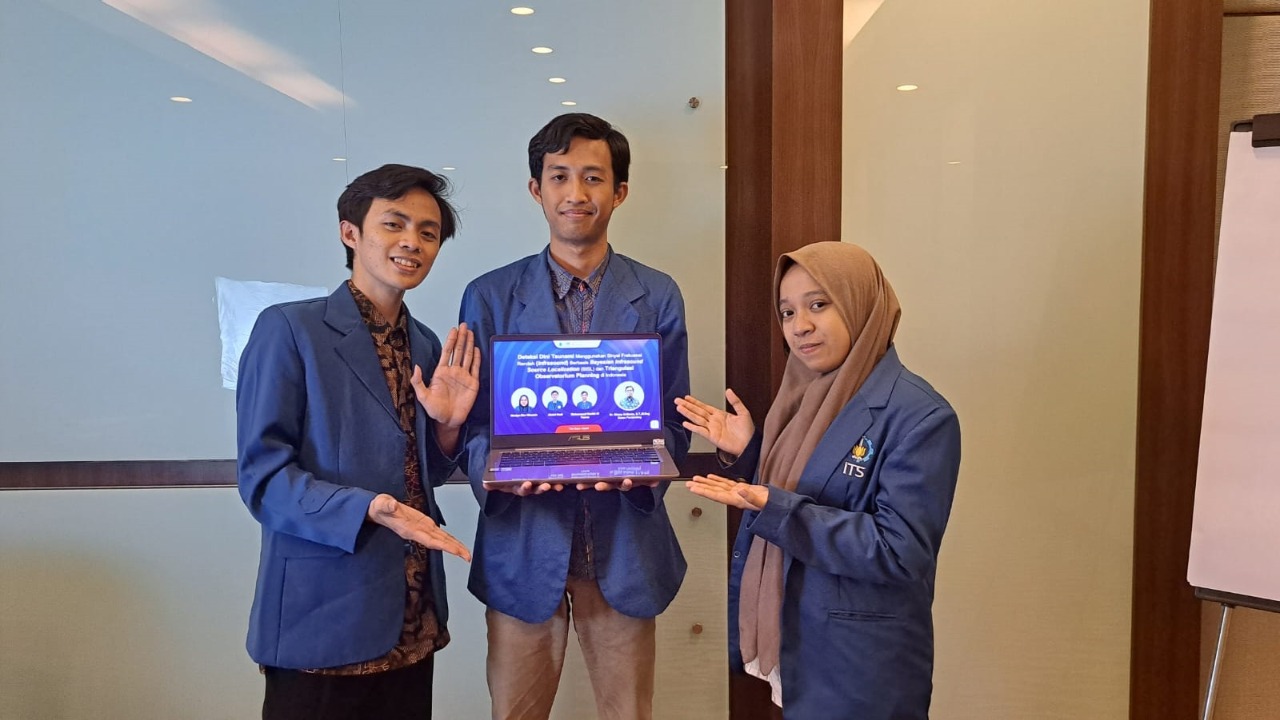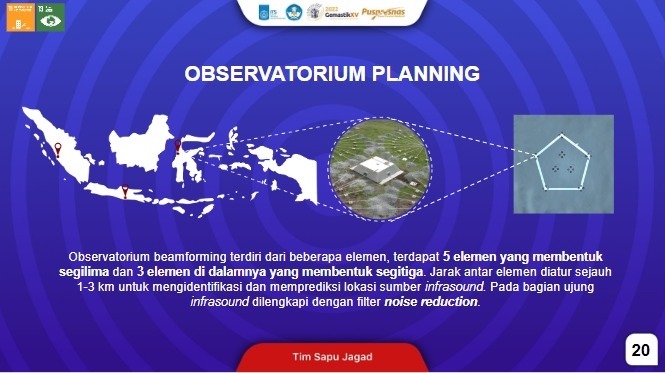Observatory, ITS Student Innovation Detects Tsunami 30 Minutes Early

(from left) Abdul Hadi, Mohammad Naufal Al Farros, and Nindya Eka Winasis after presenting Scientific Papers at Gemastik XV
ITS, ITS News – Today the tsunami natural disaster is one of the phenomena that takes a lot of lives. Seeing this fact, a team of students from Institut Teknologi Sepuluh Nopember (ITS) also initiated an innovation in the form of an infrasound-based early detection tool for tsunami natural disasters called the Observatory.
They are Abdul Hadi, Mohammad Naufal Al Farros, and Nindya Eka Winasis from the ITS Physics Engineering Department. The students who are members of the Sweep the Universe team initiated a brilliant idea which was poured in the Scientific Writing Competition (KTI) entitled Early Detection of Tsunamis Using Low Frequency Signals (Infrasound) Based on Bayesian Infrasound Source Localization (BISL) and Triangulation of Observatories in Indonesia .
The head of the Sapu Jagad team, Abdul Hadi, explained that the innovation initiated by his team was different from the existing tsunami detectors. This observatory can detect tsunamis through infrasound or low-frequency sound caused by shifts in the earth’s plates. “We use infrasound as a source of detection because it has several advantages,” explained the young man who is familiarly called Hadi.
This advantage is due to the relatively low infrasound frequency, which ranges from 0 – 20 Hertz. This makes the possibility of signal attenuation due to other signal interference very low. So that the raw infrasound graphic data obtained does not have much change and is still aligned with the infrasound waves resulting from shifts in the earth’s plates.
It doesn’t stop there, the Observatory designed by the Sweep Jagad team is designed to form a pentagonal element which will later be placed on the ground and given a distance of 1-3 kilometers between elements. Each element is also supported by a sensor that functions to detect infrasound sources that arise, as well as a noise reduction filter to minimize the presence of signals that can interfere with the Observatory detecting the location of shifts in the earth’s plates or what is often referred to as this earthquake.
In addition to providing innovation in terms of tools, the team also includes a plan for the location of the observatory in Indonesia, which is called the Observatory Triangulation. The location chosen was not arbitrary, but based on the ring of fire map, the potential disaster map, the source rock map, and the intersection of the diagonal lines made on the map.
Of the four runways, the Sapu Jagad team finally determined three location points that were planned as the location for the Observatory’s placement, namely in the cities of Malang, Padang and Palu. “The selection of these three locations has been able to reach all locations in Indonesia if an earthquake with the potential for a tsunami occurs,” explained the Head of the ITS Engineering Physics Association.

Illustration of the Observatory by the Sapu Jagad team from ITS Physics Engineering Department students along with their placement points in Indonesia
The student who was born in 2000 also stated that the workings of this tool are divided into three processes, namely detection, association and localization. The detection process is the initial process to detect whether the earthquake that occurred will cause a tsunami.
In the process, when an earthquake occurs, the Observatory sensor element closest to the earthquake location will automatically detect the infrasound point that appears. Then the infrasound signal is captured by a system called Adaptive F-Detector (AFD) to be analyzed whether the earthquake that occurred has the potential to cause a tsunami or not. If the results of the AFD analysis indicate that there is a potential for a tsunami, the AFD system will automatically issue a warning system or warning.
The AFD data in the form of a graph is then channeled to two other Observatory stations to ensure the location of an earthquake that will have the potential to cause a tsunami. In the confirmation stage, this tool is designed with the Joint’Likehood system, which is a system specially made to observe potential tsunami locations at the three existing Observatories.
In more detail, when the three Observatories receive information from each AFD system, then each Observatory will complement each other’s information to adjust the location points that have the potential for a tsunami. The cooperation of these three tools is called the association stage. When the association stage has obtained results in the form of potential tsunami location points, it is continued with the localization stage to provide accuracy of potential tsunami location points and calculate the volume of future tsunamis.
At this stage, said Hadi, a system called Bayesian Infrasound Source Localization (BISL) was used. The system will perform an analysis of the results from the association stage to provide the exact location of an impending tsunami. Then the data is processed again to estimate the magnitude of the tsunami volume that will occur. It is from the final data at the localization stage that it will then be informed to the public if a tsunami will occur at a certain location with such a tsunami volume.
Based on infrasound, this innovative tool by the Sapu Jagad team can detect a potential tsunami 15 minutes faster than other tsunami detection tools such as Buoy. Thus, the Observatory can detect a location where a tsunami will occur 30 minutes before it occurs. “That way, residents around locations that have the potential for a tsunami can have a longer evacuation time,” said Hadi.
With this innovation that focuses on disaster mitigation, the Sapu Jagad team under the guidance of Dr. Eng Dhanny Arifianto ST MEng has succeeded in bringing home a bronze medal at the XV 2022 National Student Exhibition in the Field of Information and Communication Technology (Gemastik). Hadi also hopes that innovation his team as outlined in this KTI can be realized immediately. “If our Observatory is realized and used in Indonesia, then more lives can be saved before the tsunami occurs,” he concluded hopefully. (ITS Public Relations)
Reporter: Nabila Hisanah Yusri
Related News
-
Proudly, ITS Academic Staff Achieves PAPTI Award 2024
ITS Campus, ITS News — Not only lecturers and students but also the academic staff (in Indonesian: Tenaga Kependidikan)
December 30, 2022 19:12 -
Supports Marine Sustainability, Pertamina Goes to Campus Presents at ITS
ITS Campus, ITS News — Institut Teknologi Sepuluh Nopember (ITS) became one of the partners of Pertamina Goes to
December 30, 2022 19:12 -
Anticipating Lost Pet Dogs, ITS Students Invent a Tracking Bag
ITS Campus, ITS News —Losing a pet is a sad thing for its owners. To anticipate this, a team
December 30, 2022 19:12 -
ITS Students Integrate Smart City Service Features Through Visionaries
ITS Campus, ITS News — Institut Teknologi Sepuluh Nopember (ITS) continues to prove itself as a home for talented
December 30, 2022 19:12
